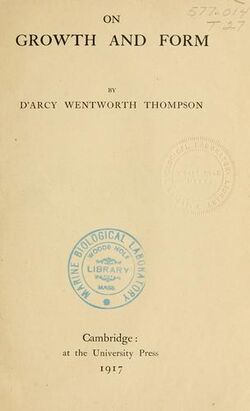On Growth and Form (nonfiction): Difference between revisions
Jump to navigation
Jump to search

No edit summary |
No edit summary |
||
| Line 1: | Line 1: | ||
'''''On Growth and Form''''' is a book by the Scottish mathematical biologist [[D'Arcy Wentworth Thompson (nonfiction)]], covering many topics, including: | [[File:On_Growth_and_Form_1st_Edition_1917_title_page.jpg|250px|thumb|Title page of first edition of ''On Growth and Form'' by [[D'Arcy Wentworth Thompson (nonfiction)]], 1917.]]'''''On Growth and Form''''' is a book by the Scottish mathematical biologist [[D'Arcy Wentworth Thompson (nonfiction)]], covering many topics, including: | ||
* The effects of scale on the shape of animals and plants, large ones necessarily being relatively thick in shape. | * The effects of scale on the shape of animals and plants, large ones necessarily being relatively thick in shape. | ||
Revision as of 17:20, 6 August 2016

Title page of first edition of On Growth and Form by D'Arcy Wentworth Thompson (nonfiction), 1917.
On Growth and Form is a book by the Scottish mathematical biologist D'Arcy Wentworth Thompson (nonfiction), covering many topics, including:
- The effects of scale on the shape of animals and plants, large ones necessarily being relatively thick in shape.
- The effects of surface tension in shaping soap films and similar structures such as cells
- The logarithmic spiral as seen in mollusc shells and ruminant horns.
- The arrangement of leaves and other plant parts (phyllotaxis)
- Thompson's own method of transformations, showing the changes in shape of animal skulls and other structures on a Cartesian grid.
The work is widely admired by biologists, anthropologists and architects among others, but less often read than cited. Peter Medawar explains this as being because it clearly pioneered the use of mathematics in biology, and helped to defeat mystical ideas of vitalism; but that the book is weakened by Thompson's failure to understand the role of evolution and evolutionary history in shaping living structures. Philip Ball on the other hand suspects that while Thompson argued for physical mechanisms, his rejection of natural selection bordered on vitalism.
In the News
Fiction cross-reference
Nonfiction cross-reference
- D'Arcy Wentworth Thompson (nonfiction)
- Richard Hamilton (nonfiction) - artist who was inspired by On Growth and Form (nonfiction)
External links:
- On Growth and Form @ Wikipedia